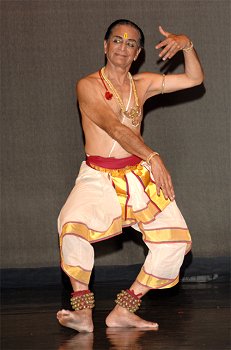
|
 |

|
 |
C V Chandrasekhar: My will power keeps me going - Lalitha Venkat November 26, 2008  A legendary dance exponent, Prof. CV Chandrasekhar fondly known as Chandru Anna and "Chandrasekhar Sir," is specialized in Kalakshetra style of Bharatanatyam under the able guidance of Rukmini Devi Arundale, the founder and director of Kalakshetra. He has imbibed from his mentor the best of Indian art, culture and aesthetics. He served the Benaras Hindu University and M S University of Baroda and retired as the Head and Dean of the Faculty of Performing Arts of M S University of Baroda. C V Chandrasekhar is a multi faceted personality being a dancer, choreographer, researcher, musician, academician, composer and highly acclaimed teacher of Bharatanatyam. He has been performing for the past six decades in India and all over the globe and is invited by many dancers the world over to teach and to choreograph. A much revered dancer in his seventies, his presentation of Bharatanatyam technique is at its finest and continues to be an inspiration for all dancers. He and his wife Jaya Chandrasekhar run their dance school Nrityashree in Chennai. As a student of Kalakshetra, how involved were you when Rukmini Devi was choreographing the Ramayana series? I had left Kalakshetra in 1954. It is only after that, that Rukmini Devi choreographed the Ramayana series. I however took part at a later stage in one show each of Sita Swayamvaram and Choodamani Pradhanam. You don many hats, as dancer, choreographer, researcher, musician, academician, composer...does any interfere with the other? It is only the time factor which at times has been a problem and there is no interference of one for the other. You are in great demand by many dancers the world over to teach and choreograph. How does that feel? It is always a pleasure to share one's experience with other dancers and their students. However, I see to it that my choreography does not change according to the style of the dancers. I teach them the movements in the way I want them to be performed. I also work only with such dancers who are prepared to understand my view and my style.  As a staunch classicist, perhaps you do not tolerate experiments in Bharatanatyam? After all, an art cannot be stagnant. Whoever told you I do not tolerate experiments in Bharatanatyam? I myself have been an experimenter with the style for more than 25 years. I was probably the first to use music other than Carnatic for Bharatanatyam. If you had watched my works of Ritusamharam, Meghadhootam, Arohanam, Pancha Mahabhootam, Krida etc, they were all experimental works based on the technique of Bharatanatyam. I have objection only to using movements which are outside the parameters of Bharatanatyam technique. I do not feel that I am stagnant. I have been moving. You have been performing for the past six decades in India and all over the globe. At this age, you are one of the busiest dancers. What would your advice be for upcoming dancers to have the stamina to keep going? I'm not sure how busy a dancer I am right now. My advice to the young dancers is to regularly be in practice irrespective of performance opportunities. That is what I have done all my life, which has kept me in good stead. My willpower is another aspect which keeps me going. How has Ramcharitamanas by Tulsidas inspired you in your dance career? The Manas has been one of the greatest inspirations in my long career, especially in North India. I was able to reach out to a large audience through this great work of Tulsi Das. I have always felt language plays a vital role in reaching out to the audience. Your point of view on Ramayana in the performing arts. Ramayana in the performing arts has been a great treasure, not only for Indian performing arts but also in the performing arts of South East Asia and the Far East. It has been a binding factor for the cultures of these countries with India and I'm confident that the Ramayana will continue to inspire the Arts forever. You attend the Natya Kala Conferences regularly. How important are conferences like the NKC for artistes? The NKC has been a yearly event much looked forward to by me, as every year has been a source of not only information but learning as well. I have grown richer and would advise all serious dancers to make time to attend these sessions however busy they may be during the Season. Your comment on the Chennai season. The Chennai Season is surely a mad time as referred to by many critics. It has however become a season for showcasing amateur dancing at the cost of performances by good, professional and serious dancers, who resist the temptation to pay and dance instead of receiving payment for the dance. However it is a gala time for the orchestra accompanying the dance. Contact: e-mail: chandjay@hotmail.com |